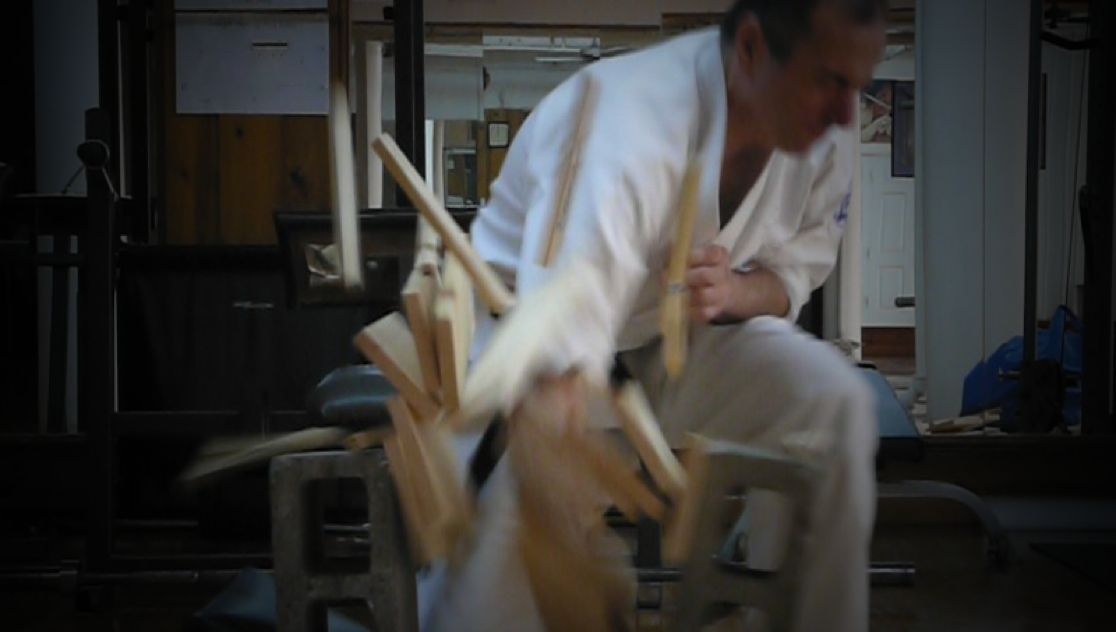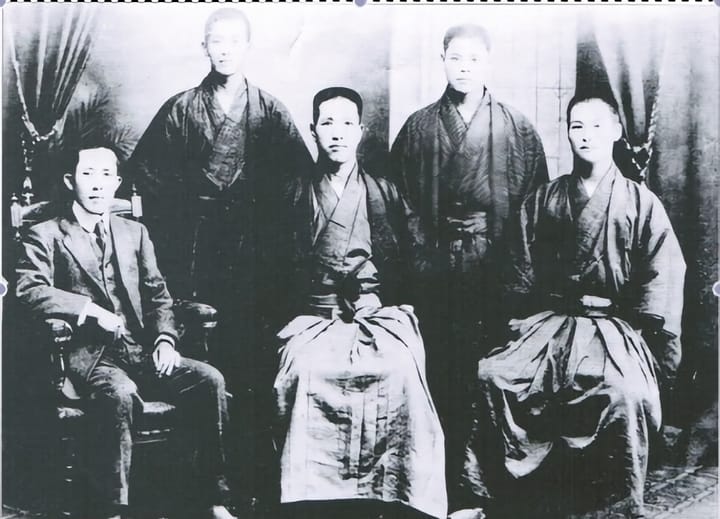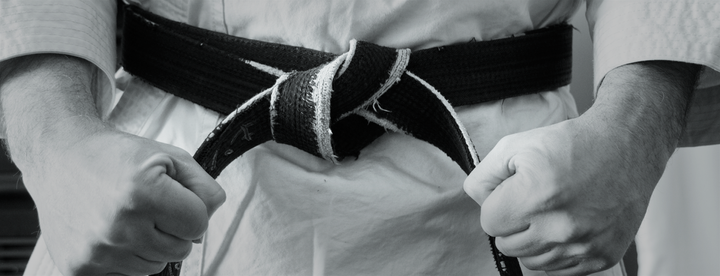These are the official, generally accepted rules for Tameshiwari (Breaking) Tournaments conducted since 2014.
The rules of Tameshiwari (Breaking) competition for all tournaments, matches, and competitions shall be as stated herein.
These rules have been developed by Goju Karate and are always located here: (https://GOJUKARATE.COM/tameshiwari-rules). The First Version of these rules was published on August 3, 2012. They have been in constant use since October 2014. This version was published on October 25, 2022. This version replaces all other versions.
NOTE: A PDF version of these rules is available for download at the end of this page.
Section 1: COMPETITION RULES
These rules follow the general form of competition rules for the World Karate Federation (WKF) and the US Olympic Committee (USOC) National Karate-do Federation (NKF) — however, these rules are specific to competition in Tameshiwari and where there is a conflict between these rules, and the rules for Kata, Kumite, or Kobudo competition of either the WKF or NKF, these rules shall supersede them.
Whenever a specific rule specified herein is in conflict with a more general rule, the specific rule takes precedence. Exceptions to these rules may be made only with the prior approval of the Tournament Referee Committee for special circumstances attendant to a particular event, tournament, match or competition. In that event, however, the rules modifications shall be made known to all competitors prior to registration, or if made after registration, in a timely manner.
Ultimately, the Tournament Director makes the irrevocable final determination regarding the implementation, enforcement, and interpretation of these rules. However, he may appoint as many Chief Referees, Referees, Scorekeepers, Timekeepers, and other Tournament Officials as may be required to perform his duties.
Section 2: COMPETITOR CATEGORIES
Tameshiwari competition may be divided into appropriate categories or divisions based upon age, gender and experience.
At a minimum, all competitions must be divided into a male and female division, and if Teen competitors are present, into a Teen Division and an Adults Division.
Teen competitors are defined as boys or girls who have reached a minimum age of 15 on the day of competition, and who are not 18 years of age on the day of competition. The Tournament Director may authorize exceptions to this rule and reclassify a competitor as eligible (in the case of a competitor outside the age range of 15-18) or ineligible, as the case may be. As stated above, there must be a Male Teen Division and a Female Teen Division.
The Adults Division shall consist of competitors who have reached the age of 18 or more on the day of competition. As stated above, there must be a Male Adults Division and a Female Adults Division.
Beyond the above categories, and at the decision of the Tournament Directory, categories that also include weight ranges, rank ranges, and age ranges may be specified. For instance, there may be a Teens 15 year of age division in both male and female categories, or there may be an Adults Division Seniors for competitors above the age of 50 (again, in both male and female categories). However, these divisions and categories are not required for a sanctioned tournament that conforms to these rules.
The ultimate placement of karateka athletes in the correct rank, age, and weight ranges is the responsibility of both the athletes, their instructors, and the Tournament Director and the Tournament Referees. Any dispute arising out of the classification of competitors shall follow the dispute resolution procedure as outlined in these rules.
Section 3: APPROVED COMPETITION MATERIALS
All materials used in a sanctioned tournament must be either provided by the Tournament or be inspected and marked via an identifying ink stamp by Referees designated by the Tournament Director.
The use of any material that does not conform to the specifications in this section are expressly prohibited, as is the use of any material provided by competitors that isn’t inspected and marked by tournament Referees. The violation of this provision will result in disqualification from competition, or if a competitor has already competed, any results from such a disqualified competitor shall be discarded as if that competitor had never competed.
The suitability of any materials used in a sanctioned tournament shall be determined entirely by Referees designated by the Tournament Director. Their decision regarding suitability of materials is final. While Referees are encouraged to communicate the reasons for a decision to disqualify materials, they are not required to do so.
For all competitors: spacers used in any event shall conform to the following specification:
- They shall be 1/2 inch by 3/4 inch or 1/2 inch by 7/16 inch in height and width.
- They shall be 10 inches in length.
- They shall be composed of any species of pine wood.
NOTE THAT SPACERS MAY BE STACKED IN ANY ORIENTATION DESIRED BY COMPETITORS TO ACHIEVE EITHER A 1/2 INCH GAP or a 3/4 INCH (OR 7/16 INCH) GAP BETWEEN BOARDS.
For TEEN COMPETITORS: boards used in any event shall conform to the following specification:
- They shall be 12 inches in length and 10 inches in width.
- They shall be 1/2 inch in height (this is the actual measured height; this is also referred to as “3/4 inch dimensional”)
- They shall be composed of #2 White Pine wood, or the equivalent.
- They may not have been treated with any chemical or foreign substance (other than being marked by Tournament Referees after inspection). In addition, they may not have been exposed to heat or cold in excess of any standard shipping temperature changes.
For ADULT COMPETITORS: boards used in any event shall conform to the following specification:
- They shall be 12 inches in length and 10 inches in width.
- They shall be 3/4 inch in height (this is the actual measured height; this is also referred to as “one inch dimensional”)
- They shall be composed of #2 White Pine wood, or the equivalent.
- They may not have been treated with any chemical or foreign substance (other than being marked by Tournament Referees after inspection). In addition, they may not have been exposed to heat or cold in excess of any standard shipping temperature changes.
Section 4: APPROVED COMPETITOR UNIFORMS AND DRESS
All competitors shall conform to the following uniform:
Standard white karate gi consisting of a gi jacket, gi pants, and rank belt. The gi may be of any manufacture and of any weight desired by the competitor.
The gi shall display appropriate dojo affiliation patches in the chest area and on one or more shoulders, if applicable to the dojo that the competitor is affiliated. If the competitor is a member of the USOC NKF, then the competitor may wear a USOC-approved patch on his or her right shoulder.
Manufacturer’s logos may be displayed provided that they are (a) discrete; (b) pertain solely to the manufacturer of the gi; (c) are embroidered onto the gi as shipped from the manufacturer and have not been added after manufacture.
No other patches, advertising materials, or other symbols may be displayed or worn.
In the event that the competitor is affiliated with a dojo that utilizes a black gi instead of a white gi, a black gi may be worn provided that (a) it conforms to all other provisions of this section; and (b) prior permission to do so has been received in writing from the Tournament Director or his representatives.
In addition to the above, the following provisions regarding dress shall be followed:
No shoe, sock, or other foot covering shall be worn, excepting if: (a) the foot covering partially covers the foot or ankle area, and is medical in nature; (b) the foot is not in any way involved in the break being performed by the competitor.
No competitor may wear any covering, including tape of any kind, on any striking surface used in any proposed break. In addition, no tape, bandage, or other method of external support is allowed on any joint (ankle, wrist, knee, hip) adjacent to a breaking surface.
Section 5: COMPETITION AREA
Breaking shall occur in the event space as designated by Tournament Officials.
At the discretion of the Tournament Director, competition events may be divided into groups if the competition area isn’t large enough to accommodate the entire competition group at one time. In the event that this occurs, competitors shall be grouped by a random draw conducted at the beginning of each round.
Prior to breaking, competitors shall have a minimum amount of time to setup their breaks. This time shall be five minutes for qualifying rounds or no-spacer traditional break events; ten minutes for all other traditional breaking events; and twelve minutes to setup for creative break rounds.
At the end of the time allotted, competitors shall stand in their designated area, but may not have any contact with the boards to be broken or any other support which is part of the break, and await instructions from the Chief Referee for the round.
Only competitors are allowed in the competition area. All competitors are permitted one assistant to setup, even if the assistant is not holding material during a break. However, any assistants not part of the break (for holding) must leave the competition area once the setup time period is over or at the command of the Chief Referee. In the case of creative break rounds, holders are permitted to remain in the competition area in order to perform their roles as holders, but they may also not have contact with any materials or support apparatus other than materials that they will hold for the break.
Only Referees, Timekeepers, and Scorekeepers are permitted in the competition area. They shall observe the tournament rules and regulations, as well as the dress code, specified by the Tournament Director.
Section 6: TYPES OF ROUNDS
There are three types of rounds in an a sanctioned tournament.
A. Qualifying Round (or alternatively: Seiken with no spacers round).
This round is the only type of round that may have two formats.
The break in this round consists of regulation boards stacked one upon another, and supported by two standard cinder blocks. No spacers are permitted and in the event that this round is a qualifying round, only seiken may be used as a weapon.
If this round is used as a qualifier, no scoring is recorded other than success or failure.
If this round is a competition round, the round is scored as specified below in the rules.
If this round is a qualifying round, all Teen Division competitors are required to break one board; Adult Division Males are required to break two boards; and Adult Division Females are required to break one board.
This round is usually the first round in any tournament.
B. Traditional Break
This round requires the use of spacers between boards. Competitors may stack as many boards as they wish, using regulation boards and spacers, and stacking the boards on two standard cinder blocks.
Any weapon may be used in this break; however, the choice of weapon does not effect the score.
This round is usually the second round in any tournament.
C. Creative Break
This round permits any configuration of boards, and the use of up to three holders holding any configuration of boards and spacers in any manner and, if desired, the use of one set of standard cinder blocks.
This round is an optional round in tournaments; if it is included, it is usually the third and last round in a tournament.
The overall design of the break must conform to the rules in this section. The Tournament Director may grant exceptions to these rules, but competitors are responsible for obtaining exceptions prior to the competition.
No design shall use or propose an action that may put fellow competitors or spectators at risk. Care must be taken to minimize the risk of injury to holders and the competitor.
No design shall employ the use of combustible or explosive materials.
In the event that boards are broken “in the air”, each holder and the competitor is permitted to launch boards, but each may only launch boards once. There is no limit on the number of boards launched.
In the event that the distance to the board being broken is a characteristic of the break, the referee is the sole judge as to whether that distance was maintained as part of the break. This decision may not be contested, protested, or appealed. The judgement of the referee in that round is final.
A competitor may propose a break that has up to three individual separate breaks, although only one break is required.
Spacers may be used for all or some of the breaks.
No material may be taped together, or otherwise held together, except by being held by an assistant during a break.
No material that is involved in a break may be padded or taped, nor may a cover be placed over material to lessen impact or contact damage to the competitor.
Section 7: COMPETITION SEQUENCE
A. At the start of competition, the Chief Referee shall instruct competitors as to whether they will break simultaneously, or in smaller groups, or individually.
B. The referee(s) shall examine the break setup for conformance to all rules. Successful conformance with rules shall be announced.
C. In the event of a traditional qualifying break, traditional no-spacer break, or a traditional breaking round, the total number of boards shall be noted and recorded for each competitor.
The total number of boards shall be announced at each station.
In the event of a creative break round, the setup and action of the break shall be inspected and confirmed, and the total number of boards shall be recorded.
In the event of a creative break round, all scores for creativity, difficulties, weapon-type, etc. shall be computed and recorded. No intermediate scores of any kind shall be announced, other than the total number of boards.
D. The Chief Referee shall instruct the timekeeper to prepare the start signal.
E. The start signal shall sound.
Competitors have 120 seconds from the start signal to begin their break and complete it. In the event the competitor does not make contact with a breaking target surface within that 120 seconds, he or she shall be disqualified and the score set to zero.
Once the 120 second time period has elapsed, the finish signal shall sound. Once the signal has sounded, competitor(s) must step back and stand in fudo dachi and await final scoring based on break success. Failure to do so shall result in a success score of zero.
F. Once the finish signal has sounded, and all competitors have stepped back, the Referees will inspect each break and note its success, and if all boards haven’t been broken, the total number of boards broken.
G. At the conclusion of all breaks, the final scores will be announced. The winner, and if the Tournament Director indicates, the second and third place scores, will be announced.
Section 8: SCORING
A. Qualifying Round (or alternatively: Seiken with no spacers round).
If this round is used as a Qualifying Round, the only score is Success or Failure. To be scored a success, all the boards setup must be broken. In the event a competitor sets up more than the minimum number of boards required, and fails to break all the boards, the score shall be considered Fail.
If the round is a full competition round (Seiken with No Spacers), than the total score is equal to the number of boards setup and successfully broken. If any boards setup are not broken, then the total score for the round is zero.
B. Traditional Break
The total score is equal to the number of boards setup and successfully broken. If any boards setup are not broken, then the total score for the round is zero.
C. Creative Break
The total score is the sum of six different scores.
- Number of boards broken. In the event that all the boards are not broken, this score is zero.
- Position of the boards. Fixed on cinder blocks = 1; held by assistants = 3 (per hold; maximum of 9 points); boards broken in the air = 10
- Weapon Used (per break). Elbow = 2; Tettsui= 2; Seiken = 3; Sunei = 3; Shuto = 4; Chusoku = 4; Kakato = 4; Heisoku = 6; Atemi = 6; Koken = 7; Heito = 7; Nukite (any) = 14. If a weapon not listed here is used, the Chief Referee shall determine the closest equivalent weapon and score it appropriately.
- Difficulty of break [1-5]. A score of one is equivalent to a shuto break with spacers; a score of two is akin to a seiken break with no spacers; 3-5 is based on the judgement of the referee.
- Creativity [0-3]. 0 is a standard break on blocks with or without spacers; 1-3 points is based on the judgement of the referee.
- Successful break (all boards broken) 10 points
Note that the scores for items 2-5 are computed BEFORE the break, but may be modified by the referees in the event that the break is not performed according to the specifications of the break. The modification is noted as a penalty, equal to the points granted beforehand (effectively, to zero-out that part of the break not performed).
In addition, while the score for item 1 can’t be computed in advance, the total number of boards is noted BEFORE the break.
After the break, the scores for item 1 and item 6 is added and the final score is computed.
Section 9: REGISTRATION
All competitors are required to have completed and submitted all registration materials prior to entry to the Tournament. The Tournament Director may, at his sole discretion, allow on-site registration.
All competitors are required to have submitted a description of their intended break (using text and/or diagrams) prior to the Tournament. At the discretion of Tournament Officials, a late-entrant may be permitted to compete, but must submit such a description prior to the start of competition.
Tournament Officials have the unlimited right to disqualify a proposed break for any reason. In the event that a break is disqualified, the Competitor may submit a revised break plan; however, Tournament Officials may decide that a competitor may not resubmit a plan, and disqualify him or her from competition.
Section 10: CONDUCT
At all times, Competitors will conduct themselves in the full spirit of karatedo; failure to do so is grounds for immediate disqualification by the Chief Referee for the round or any other senior Tournament Official. Violations under this section are entirely subject to the interpretation of the Tournament Director, and all decisions taken under this section are final.
Further, instructors and dojo officials are also expected to conduct themselves according to the full spirit of karatedo. This includes respectful speech and actions towards other competitors and all tournament officials.
Spectators are expected to conduct themselves appropriately and in the spirit of good conduct and proper manners as with any public event.
Section 11: APPEALS, PROTESTS, REQUEST TO RECONSIDER, PENALTIES
Scoring decisions, including requests to reconsider and recompute scores may be made to the Chief Referee for the round within five minutes of the ending of the round and announcement of scores and the winner. No request may be made after five minutes have elapsed.
In the event that the Chief Referee declines to reconsider or recomputed a score, a further appeal may be made within five minutes of the decision of the Chief Referee. This appeal may only be made to the Tournament Director. The Tournament namant Director may decline to consider the request for any reason, or may reconsider or recompute the score. In any event, no further appeal is permitted.
Any other appeal, protest, or request to reconsider a decision made under these rules must be made directly to the Tournament Director. The Tournament Director may decline to consider the appeal, solely within his own discretion. No further appeal or request to reconsider is permitted once the Tournament Director has made his determination.
In the event that these rules are violated, the Tournament Director, by and through his duly authorized representatives, may impose one or more of the following sanctions: verbal reprimand, written warning, monetary fine, or disqualification or suspension.
Section 11: AGREEMENT TO ABIDE BY THESE RULES; ACCEPTANCE OF RISK
All participants, including spectators, competitors, and instructors supporting competitors, agree to abide by, and be subject to, these rules.
FURTHERMORE, ALL PERSONS WHO ELECT TO COMPETE IN ANY EVENT AUTHORIZED AND SANCTIONED UNDER THESE RULES DO SO AT THEIR OWN RISK, RECOGNIZING THAT KARATE COMPETITION NECESSARILY INVOLVES SOME RISK OF SERIOUS, PERMANENT PHYSICAL INJURY OR DEATH.
NO LIABILITY FOR ANY LOSS, INJURY OF ANY KIND, OR DEATH, SHALL ATTACH TO THE ORGANIZERS OF ANY TOURNAMENT CONDUCTED UNDER THESE RULES OR ANY OF THEIR OFFICERS, DIRECTORS, MEMBERS OR EMPLOYEES, ETC. FOR ANY CAUSE OF REASON ARISING OUT OF, OR SUSTAINED IN ANY COMPETITION CONDUCTED HEREUNDER, INCLUDING NEGLIGENCE OR GROSS NEGLIGENCE.





